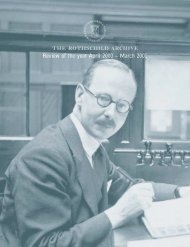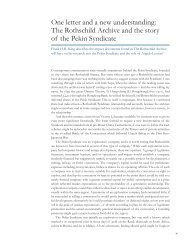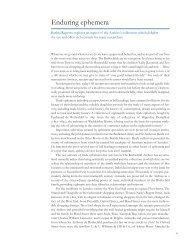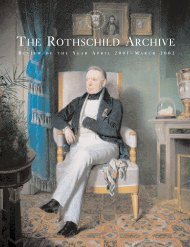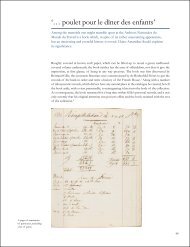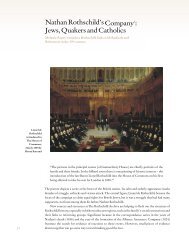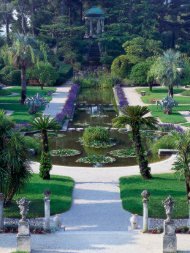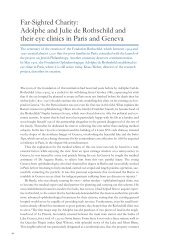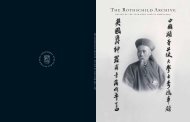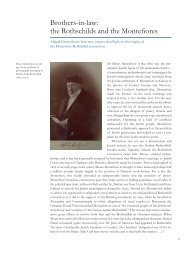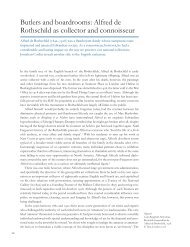66900 Rothschild Archive - The Rothschild Archive.
66900 Rothschild Archive - The Rothschild Archive.
66900 Rothschild Archive - The Rothschild Archive.
You also want an ePaper? Increase the reach of your titles
YUMPU automatically turns print PDFs into web optimized ePapers that Google loves.
to enthusiasm, generosity and inventiveness when it was a question of scraping together funds<br />
to secure the limited number of first-rate masterpieces he thought the Gallery should concentrate<br />
on. In 1909 <strong>Rothschild</strong> expressed his support for the idea of a Reserve Purchase Fund. He<br />
also drafted a letter that he suggested could be sent to the owners of key masterpieces, asking<br />
them to give the Gallery first refusal in event of a sale. Both were ideas considered by the 1913<br />
Curzon Committee, which tackled the whole issue of art sales abroad. ₁ ⁹ Art critics like D.S.<br />
MacColl had used the power of the press to draw public attention to the issue, and were among<br />
the founding fathers of the National Art Collections Fund established in 1903. <strong>Rothschild</strong><br />
welcomed public participation in the ‘rescue’ campaigns organized by the NACF, which began<br />
in 1906 with that to save Velazquez’ Rokeby Venus.<br />
Far from seeing them as exceptional, desperate efforts by outsiders to compensate for the<br />
failure of the Establishment to act (as MacColl and his allies did), if anything such public campaigns<br />
fuelled a certain complacency in Alfred’s thought on acquisitions policy. Together with<br />
a reassuringly high price tag, such outcry was a valuable way of checking that the Gallery was<br />
going after the right works. No expertise or powers to buy abroad were needed here. In his<br />
eagerness to keep it out of the hands of ‘so called experts’ Alfred seemed willing to outsource<br />
acquisition policy to the great British public, even if that ran the risk of pandering to public<br />
taste, rather than educating it. As he wrote to fellow Trustee Viscount D’Abernon in 1909 ‘I<br />
think that whatever the National Gallery buys ought to possess such undoubted merit and<br />
attractiveness, that the verdict of the public would be unanimous in approving of our purchases<br />
…’²⁰ This may explain his fierce opposition to exhibiting the Impressionist and Post-<br />
Impressionist collection of Hugh Lane at the Tate. Manet and Renoir’s work, Alfred fumed,<br />
‘would disgrace the one-armed man who chalks on the flagstones of the streets’.² ₁ Here, as with<br />
his preference for ‘attractive’ women in paintings, he was guilty of failing to reconsider his own<br />
taste, or make a distinction between its demands and the wider criteria that necessarily held in<br />
considering acquisitions for a national collection.<br />
Alfred’s disdain for the experience and knowledge of curators could take rather patronising<br />
forms. One Keeper of the Gallery who survived Alfred only to quit the Gallery in 1932 in disgust<br />
at continued Trustee arrogance was Charles Collins Baker. After his departure he passed<br />
on his recollections to his friend, the well-known critic and Keeper (1911–24) of the Wallace<br />
Collection D.S. MacColl. <strong>The</strong> following account mingles Collins Baker’s own memories with<br />
those of a predecessor, George Ambrose, providing one final insight into just how deeply<br />
etched into the Gallery’s collective consciousness this particular Trustee’s behaviour was:<br />
Archibald Primrose,<br />
5th Earl of Rosebery<br />
(1847–1929) husband of<br />
Hannah de <strong>Rothschild</strong>.<br />
Ambrose … recounted over and over again how once A. <strong>Rothschild</strong> had turned on Hawes<br />
Turner [the Keeper], who had been sticking up for the Lane Collection, and in the<br />
presence of the rest had told him (Turner) not to go miaowing about the place like a cat:<br />
and A.de R. (to Ambrose’s great delight) had given an imitation of Hawes Turner’s voice,<br />
travestied with ‘miaows’. In no time I began to see for myself. In full meeting A.de R.<br />
referring to Holroyd, said if he were one’s butler and brought up a corked bottle of wine<br />
one would spit it out: and he gave another excellent imitation (on my right sleeve) of<br />
expelling corked wine. This was apropos of Holroyd submitting a picture which A.de R.<br />
thought ugly.<br />
<strong>The</strong> whole atmosphere, he continued was one of ‘de haut en bas, contempt of scholarship’,<br />
meekly accepted by the staff.²²<br />
Even after Alfred’s demise in 1918 the model of heavily ormulu’d Trusteeship he had introduced<br />
lived on until the Second World War. During the 1920s and 1930s the Board was<br />
thronged with other dandies and incroyables noted for their exquisite fashion and opulent entertaining.<br />
Among these was Philip Sassoon, also of Jewish extraction. Actually, Sassoon was a<br />
relative of Alfred’s; his mother Aline was born a <strong>Rothschild</strong>.<br />
32



